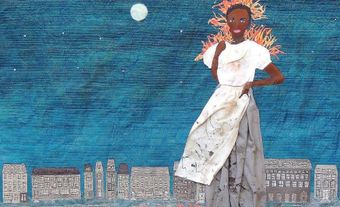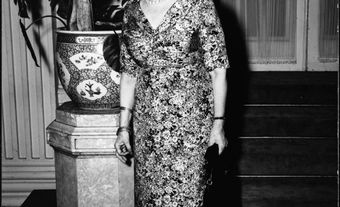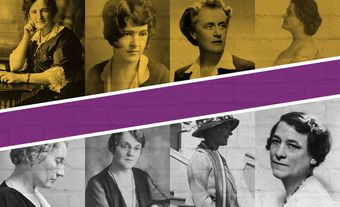
Women, Feminism and the Quiet Revolution
At the dawn of the 1960s and the ushering in of the Quiet Revolution , feminism in Quebec had lain dormant since the late 1940s. It was not until the election of Claire Kirkland-Casgrain , the first female member of the Legislative Assembly, on 14 December 1961 that a new feminism (often referred to as second-wave feminism) emerged (see Women’s Movements in Canada: 1960–85 ). Since 1940, when women in Quebec had obtained the right to vote in provincial elections, the various feminist organizations in Quebec and Canada had all but disappeared (see Early Women’s Movements in Canada: 1867–1960 ).

Nevertheless, in July 1960, in the wake of the Cold War , a pacifist organization called Voice of Women , was founded in Toronto . It united women who opposed the proliferation of nuclear weapons and wanted to promote peace in the world. In Quebec, Thérèse Casgrain became the president of this association and created the province’s branch in 1961. More than 500 women became members of Voice of Women in Quebec, including Simonne Monet-Chartrand , Léa Roback and Solange Chaput-Rolland . During its existence, this association organized national conferences and participated in global meetings in Geneva and Vienna.
The election of the government of Jean Lesage on 22 June 1960 marked the beginning of what is now known as the Quiet Revolution and brought with it major economic, social and cultural reforms. Without question, these reforms had significant repercussions on the lives of women in Quebec. The year 1960 was also when the birth control pill was first marketed in Quebec, though officially it was prescribed only to regulate menstrual cycles and reduce the associated aches and pains. Despite this, many women, both in Quebec and throughout Canada, succeeded in obtaining prescriptions to use it as a method of contraception. The names of doctors who readily prescribed the pill quickly spread among Canadian women (see Birth Control ).
October 1960 also saw the birth of a new magazine, Châtelaine , which dealt with women’s issues, including contraception, amendments to the Civil Code of Quebec and the working lives of women. From its beginning, under the leadership of Fernande Saint-Martin , Châtelaine took a distinctly feminist tone and reached a large readership. Five years later, women in Quebec discovered Radio-Canada ’s daily television program Femme d’aujourd’hui. Around 1967, its producer Michelle Lasnier and host Aline Desjardins took this already-popular show in a new direction, breaking away from traditional models and social issues. Broadcast until 1982, the program dealt with subjects such as emancipation, women in the labour force , family planning and divorce .
Election of the First Female Member of the Legislative Assembly of Quebec
On 14 December 1961, Claire Kirkland-Casgrain was elected in the riding of Jacques-Cartier during a by-election. As the first female member of the Legislative Assembly of Quebec, she spearheaded Bill 16, which established legal autonomy for married women in a range of areas by amending the Civil Code (see Women and the Law ) in 1964. That same year, she became the first woman to lead a ministry as Quebec’s minister of transport and communications.
Growing Participation of Women in the Workforce
The Hospital Insurance Act, which came into effect on 1 January 1961, drastically transformed hospital administration and staff working practices. Previously, nuns had managed Catholic social services and hospitals in Quebec for close to three centuries; they were widely replaced as heads of these institutions by secular male administrators. Furthermore, the Hospital Insurance Act allowed for the creation of new jobs in various hospital professions, particularly in technical fields.
These jobs quickly came to be held mostly by secular women, who began to enter the workforce in greater numbers in the 1960s. At Sainte-Justine Hospital in October 1963, these were the first union members in the health care field to go on strike, to the great dismay of the hospital’s founder Justine Lacoste-Beaubien . During this illegal strike, the hospital’s 235 nurses, affiliated with the Confederation of National Trade Unions , demanded deduction at the source for union dues, better working conditions and supervisory power over health care organization (see Nursing ). It was the first hospital strike in Quebec. Without a doubt, the women’s 30-day strike had an impact not only on union organization in Quebec, but also on the operation of hospitals, which, over the years, would divide up employee duties. Furthermore, each type of job in the health care system would have defined responsibilities and a pay scale accompanied by a specific salary.
Access to Education for All
After tackling hospital insurance, the Lesage government, at the request of Paul Gérin-Lajoie , formed the Royal Commission of Inquiry on Education in the Province of Quebec on 21 April 1961. It became better known as the Parent Commission, in reference to its president, Mgr Alphonse-Marie Parent. Two women were appointed to the commission: Sister Marie-Laurent de Rome (Ghislaine Roquet), a philosophy professor at the Basile-Moreau women’s college, and Jeanne Lapointe, a literature professor at the Université Laval . They would ensure that new high schools were equally accessible to girls and boys.
In their report, published in 1963 and 1964, the commissioners recommended the establishment of free schooling from the elementary level to college, mixed-gender classes, the creation of high schools and collèges d’enseignement général et professionnel (Cégeps), as well as equal access for boys and girls to all programs of study. This educational reform gave girls and women in Quebec genuine access to post-secondary education and opened up a number of career choices (see Women and Education ).
Equality before the Law
The amendment to the Civil Code of Quebec was another significant reform adopted in 1964. It granted married women unprecedented legal autonomy from their husbands. Also, they no longer required a husband’s signature to sign a contract, open a bank account or take out a bank loan. They could practise a different profession from their husband, which the Civil Code had prohibited in principle. They could also now be executrices and trustees and file lawsuits.
Creation of Two New Women’s Associations in 1966
The year 1965 marked the 25th anniversary of women gaining the right to vote in Quebec. For the occasion, Thérèse Casgrain decided to organize a symposium entitled La femme du Québec: Hier et aujourd’hui (The Quebec Woman: Yesterday and Today), which saw attendance from most of Quebec’s feminist organizations. Women at the symposium took stock of the status of women in Quebec and discussed a wide range of topics including the right to divorce, maternity leave, day care , equal pay, women’s working conditions, contraception and the matrimonial regime (see Marriage in Canada ). At the end of the symposium, they unanimously voted to create the Fédération des femmes du Québec (FFQ), which came into being in June of the following year. Most women’s groups in Quebec joined it. From its foundation, the FFQ professed to be non-denominational and non-partisan.

In September 1966, the Association féminine d’éducation et d’action sociale (AFEAS) was created when the Cercles d’économie domestique (Homemakers’ Circles) and the Union catholique des femmes rurales joined forces. The AFEAS denounced the lack of visibility for women’s work within the agricultural sector, in rural areas, and elsewhere. From its inception, the AFEAS had 35,000 members, most of whom were mothers. Contrary to many other women’s groups in Quebec, its leaders decided not to join the FFQ to maintain the organization’s autonomy and out of mistrust of the FFQ’s stated religious neutrality.
Creation of a Family Allowance Program in Quebec
In 1967, the Quebec government decided to create its own family allowance program as a supplement to that of the federal government. The program allowed mothers in Quebec to receive extra money to support their children, which helped single mothers in particular.
Bird Commission
The year 1967 was also marked by the first hearings of the Royal Commission on the Status of Women in Canada , also known as the Bird Commission, after its chair, Florence Bird , a Toronto woman who also became the first woman to lead a commission of inquiry in Canada. Established by Lester Bowles Pearson’s Liberal government following pressure from women’s groups, the commission’s mandate was to study the status of women in Canada and to make recommendations to the federal government to ensure their equality (equal opportunities) in all aspects of Canadian society.

During this commission, the Indigenous women who spoke expressed how much the Indian Act denied them their ancestral rights. In fact, according to that law, marrying a white man would cause them to lose their Aboriginal status and the rights tied to it, namely the ability to live on a reserve. It was the desire to amend this law, among other things, that led to the foundation of the association Equal Rights for Native Women, led by Mary Two-Axe Earley , in Quebec in 1967. It was the first association for Indigenous women in Canada.
During its mandate, the Bird Commission conducted studies on a variety of subjects and received 468 written submissions and approximately 1,000 letters. It held public hearings in 14 Canadian cities, in which 890 people came forward to speak. Its report, which contained 167 recommendations, was submitted to the federal government on 28 September 1970. The main recommendations had to do with equal pay, the establishment of maternity leave, the creation of childcare services, birth control and the right to abortion , family law reform, education and women’s access to management positions, part-time work and alimony .
Right to File for Divorce and Decriminalization of Abortion in Hospitals
On 1 July 1968, two years before the Bird Commission submitted its report, Pierre Elliott Trudeau ’s federal government introduced legislation allowing Canadian women to file for divorce. In cases of divorce on the basis of adultery, the woman now had the right to a separate home. This right had formerly been reserved exclusively for the husband, as a women’s infidelity was considered more serious than a man’s. The law also recognized physical or mental cruelty as grounds for divorce. During the same year, the Quebec government passed a law recognizing civil marriage.
In 1969, the Civil Code of Quebec was amended to replace the matrimonial regime of community of property with that of partnership of acquests. Among other things, this law ensured that, during a separation, all property acquired by a couple over the course of their life together had to be shared equally between the man and the woman. However, each spouse would keep any property he or she possessed prior to the marriage that were received as a gift or bequest or through succession .
Also in 1969, the Trudeau government amended the Criminal Code to legalize abortion in hospitals. However, abortions had to be authorized by a therapeutic committee beforehand, following an evaluation of the physical and mental health of the mother-to-be. In all other circumstances, abortion remained a criminal act in Canada, and doctors who performed them outside of hospitals, such as Henry Morgentaler , faced possible imprisonment.
Social Aid Act
In late 1969, the Quebec government passed the Social Aid Act, following the recommendations of the Boucher Report, submitted in 1963. Transforming the government’s approach to social security, this act allowed single mothers to receive benefits without undergoing the review procedures, which were often seen as humiliating and had been set out under the Needy Mothers Assistance Act since 1937. This previous regime had been introduced by the Union Nationale government of Maurice Duplessis .
Emergence of Radical Feminism
The 1960s of the Quiet Revolution ended with the birth of an increasingly radical branch of feminism that conflicted with Quebec’s moderate feminists. In October 1969, the Front de libération des femmes du Québec (FLFQ) was created in Montreal. Inspired by Marxism , the FLFQ aggressively denounced the oppression of women in everyday life. The FLFQ organized protests and sit-ins to make their voices heard. These radical feminists were the first group of organized and independent women to bring a new strength to the feminist movement of the 1970s, one that would prove more assertive and demanding than in the previous decade.

 Share on Facebook
Share on Facebook Share on X
Share on X Share by Email
Share by Email Share on Google Classroom
Share on Google Classroom




